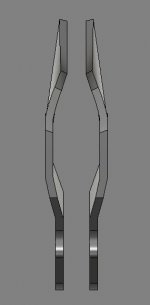LostFab
Aluminum
- Joined
- Jul 12, 2016
- Location
- Cascadia, Washington
I am designing a welded steel frame that needs to have two parallel plates bow away, and then back towards each other to encompass a component. The plates are approx. 1/4" thk, 2" wide, and 12" tall, the bends are maybe 25* and add about 1" to the overall width of the structure. These brackets will need to have some machining done to lighten them up and locate a few tight tolerance bearing seats before they get welded together. The way I see it I have three options to make these parts:
1-Bend the parts from 1/4", and machine. I tried this before, it was essentially impossible to get the bends close enough to nominal geometry that I didn't end up having to machine the whole surface down a bit undersize to hit parallelism tolerance of bearing surfaces. And it ended up cracking on the bends after some testing...
2-Machine the whole part from oversized bar. Seems like a lot of chips to make, and more material expense, but the material is less likely to spring around on me.
3-Bend parts from something in between, like 3/8" where I know I will have plenty of material to remove but not hopefully too not much extra. Bend tolerances don't have to be as tight, and thicker material around the bends seems like it would mitigate the cracking issue from before as well.
Am I off my rocker thinking bending any material regardless of thickness wont totally screw this up?
Pics show the approximate geometry of the part, its still in the design process as I figure out how I want to go about making it. I did locate the critical tolerance features on the same plane this time around so I don't have to worry as much about hitting their tolerances relative to one another.


1-Bend the parts from 1/4", and machine. I tried this before, it was essentially impossible to get the bends close enough to nominal geometry that I didn't end up having to machine the whole surface down a bit undersize to hit parallelism tolerance of bearing surfaces. And it ended up cracking on the bends after some testing...
2-Machine the whole part from oversized bar. Seems like a lot of chips to make, and more material expense, but the material is less likely to spring around on me.
3-Bend parts from something in between, like 3/8" where I know I will have plenty of material to remove but not hopefully too not much extra. Bend tolerances don't have to be as tight, and thicker material around the bends seems like it would mitigate the cracking issue from before as well.
Am I off my rocker thinking bending any material regardless of thickness wont totally screw this up?
Pics show the approximate geometry of the part, its still in the design process as I figure out how I want to go about making it. I did locate the critical tolerance features on the same plane this time around so I don't have to worry as much about hitting their tolerances relative to one another.




